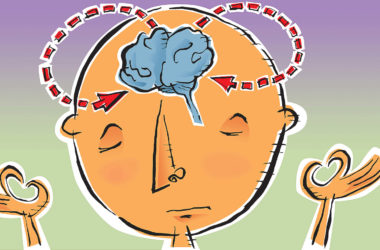Mindfulness is one of the best tools to stay calm and balanced and sharpen job concentration and performance amid pandemic uncertainty. You can practice mindfulness in several different ways and to varying degrees. If you have the time, dedication, and interest, you can practice focused attention mindfulness meditation. You set aside time in the day to sit down in a quiet place and focus your attention on your breathing, a mantra, or another object of concentration. The equivalent in building an exercise regimen would be working out on a StairMaster for twenty minutes a day or going to the gym for an aerobics class three times a week.
If you want to go hog wild, you can attend an intensive event at a mindfulness workshop or retreat center. Mindfulness intensives are held in a specific place with a group of people often in silence, for an extended period of time. The exercise equivalent would be biking in the Tuscan countryside for a week or going to a weight-loss spa for several days. There are many excellent retreat centers across the United States. The major ones are listed in the appendix.
But if meditation is new territory for you, a good entry into mindfulness is open awareness meditation. You can practice it with a minimum of time and dedication by simply being mindful during activities such as eating, cooking, walking, and working that are already built into your day.
You could even practice open awareness right now. As you read on, you might find your mind wandering from time to time. Just be aware of your wandering mind, accept that wandering, and gently bring your mind back to the words on the printed page. An open awareness exercise can be any brief activity that makes you aware of what’s happening as it’s happening in the flow of your daily routines. One open awareness exercise is to be mindful of your thoughts. Another is to be aware of all the sounds around you. A third type of open awareness exercise takes you beyond yourself with moments of mindful awareness that pertain to any activity you’re deliberately paying attention to in the present.
You intentionally walk with present-moment awareness by bringing your attention to the sensations of your feet against the ground, or by noting the feel of the air, sights, and sounds around you as you walk. When you weed the garden, you can pay attention to the plants’ resistance against your hands as you tug on them, and the sound of stubborn roots and smells of fresh soil as you unearth the weeds from their home.
When you clean the toilet bowl, brush your teeth, drive your car, or cook a pot of soup, you can step out of your thought stream and make yourself fully present in the activity. While waiting in the doctor’s office, you can practice mindful listening. In line at the grocery store, you might tune in to your body sensations. Stuck in traffic, you can practice mindful deep breathing.
You can do the following brief mindfulness exercises during your workday:
- Take off your socks and shoes and feel your toes in the carpet. Pay close attention to how the carpet feels against your feet. If you have an open window, focus on the sounds of chirping birds or inhale the fragrance of a flower.
- During lunch, sit down and give food your full attention, being present with each bite. Pause before starting a meal, noticing the colors and textures while inhaling the smells of the food. Eat your lunch slowly and deliberately. Chew food two or three more times than you usually do to taste it fully, paying attention to each ingredient and savoring each morsel. You will taste your food in a completely different way; for example, instead of tasting tuna salad, discover the flavor of celery as it crushes against your teeth, the bursting tartness of pickles, and the blending of the tuna and green lettuce. Take a sip of a beverage and be with the sensation against your tongue and stay with the felt sense as it slides down the back of your throat.
- After eating, stand and stretch your body. Let yourself fully feel the stretch, noticing where tension is held and released. Shake the part of your body where you sense tension. As you continue to stretch, bring your attention to each part of your body that has remained tightened. Bend over and touch your toes and feel that stretch, visualizing the tension in your body evaporating.
A Mindful Working Exercise
The following open awareness exercise can help you slow down and pay closer attention to your body, mind, and spirit during your workday:
The next time you go back to your workplace after being quarantined for a while, imagine you have entered your it for the first time. Notice the entranceway, the architecture of the outside and inside of the building, and the people at their work stations or lack thereof. Look at your coworkers as if you’ve never seen them before, seeing and appreciating them with renewed interest. Notice what hangs on the walls and the textures and colors of the walls, ceiling, and floor. Smell the flowers on someone’s desk. Be aware of how your colleagues are dressed and the colors of a blouse or jacket a colleague is wearing. Pay attention to who conforms to rules and who marches to the beat of their own drum. Who is wearing masks and gloves and keeping six feet of distance? And who isn’t? What sounds do you hear, and what smells (such as cologne or freshly brewed coffee from the break room) permeate the air?
Be mindful of your coworkers’ faces. Look into the eyes of a business associate, subordinate or boss. Then look beyond their facial expressions and into their hearts, where their true selves reside, noticing what’s imprinted there. Do they look happy or worried? Ready to embrace the day or wishing they were back home in bed? Are they smiling or frowning? Who has wrinkles and worry lines, and whose face is stress-free? Do people in this work environment touch each other or keep their distance? Do they affirm one another or put each other down with sarcasm and cutting remarks? Are they pulling together as a team or working against one another?
Notice what you’re thinking and feeling as you mindfully examine your workplace. If you notice yourself making judgments, try not to judge yourself for judging. Instead, see if you can substitute curiosity and compassion for the people or situations you’re judging. Then after you’ve completed the exercise at work, try it when you get home with your housemates. The goal is to stay in the present moment, substitute curiosity for judgment and notice the shifts inside your body. Chances are you will land in your C-Spot: calm, clarity and compassion for others.



